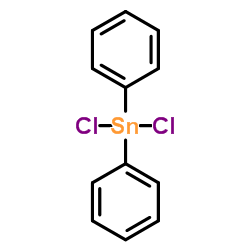Dichloro(diphenyl)stannane

Dichloro(diphenyl)stannane structure
|
Common Name | Dichloro(diphenyl)stannane | ||
|---|---|---|---|---|
| CAS Number | 1135-99-5 | Molecular Weight | 343.824 | |
| Density | N/A | Boiling Point | 330.7±25.0 °C at 760 mmHg | |
| Molecular Formula | C12H10Cl2Sn | Melting Point | 41-43 °C(lit.) | |
| MSDS | Chinese USA | Flash Point | 153.8±23.2 °C | |
| Symbol |


GHS07, GHS09 |
Signal Word | Warning | |
|
Speciation studies of diorganotin(IV) complexes with 3,3-bis(1-methylimidazol-2-yl)propionate--displacement reaction by DNA constituents.
ScientificWorldJournal 2013 , 106357, (2014) The interaction of 3,3-bis(1-methylimidazol-2-yl)propionate (BIMP) with dimethyltin(IV) dichloride (DMT), dibutyltin(IV) dichloride (DBT), and diphenyltin(IV) dichloride (DPT) is investigated at 25°C and 0.1 M ionic strength in water for dimethyltin(IV), and ... |
|
|
The proteasome is a molecular target of environmental toxic organotins.
Environ. Health Perspect. 117 , 379-86, (2009) Because of the vital importance of the proteasome pathway, chemicals affecting proteasome activity could disrupt essential cellular processes. Although the toxicity of organotins to both invertebrates and vertebrates is well known, the essential cellular targ... |
|
|
New approach of solid-phase microextraction improving the extraction yield of butyl and phenyltin compounds by combining the effects of pressure and type of agitation.
J. Chromatogr. A. 1072(1) , 19-27, (2005) A new methodology for the simultaneous and fast solid-phase microextraction (SPME) of butyl- and phenyltin compounds, as ethylated derivates, is proposed in this paper. The effects of pressure and type of agitation during headspace SPME sampling are evaluated... |
|
|
Simultaneous determination of four organotins in food packaging by high-performance liquid chromatography-tandem mass spectrometry.
Food Chem. 181 , 347-53, (2015) A simple method based on high-performance liquid chromatography-tandem mass spectrometry (LC-MS/MS) was developed for the simultaneous determination of organotins-tri-n-butyltin chloride (TBT), triphenyltin chloride (TPT), dibutyltin dichloride (DBT), and dip... |
|
|
Certification of butyltins and phenyltins in marine sediment certified reference material by species-specific isotope-dilution mass spectrometric analysis using synthesized 118Sn-enriched organotin compounds.
Anal. Bioanal. Chem 387 , 2325-34, (2007) A new marine sediment certified reference material, NMIJ CRM 7306-a, for butyltin and phenyltin analysis has been prepared and certified by the National Metrological Institute of Japan at the National Institute of Advanced Industrial Science and Technology (N... |
|
|
Synthesis and structure-activity correlation studies of metal complexes of alpha-N-heterocyclic carboxaldehyde thiosemicarbazones in Shewanella oneidensis.
Int. J. Environ. Res. Public Health 2(1) , 170-4, (2005) This investigation involved the synthesis of metal complexes to test the hypothesis that structural changesand metal coordination in pyridine thiosemicarbazones affect cell growth and cell proliferation in vitro. Thiosemicarbazones are well known to possess a... |
|
|
Antioxidative effect of quercetin and its equimolar mixtures with phenyltin compounds on liposome membranes.
J. Agric. Food Chem. 54(20) , 7735-46, (2006) Our earlier studies have shown that the compounds diphenyltin dichloride (DPhT) and triphenyltin chloride (TPhT) in the presence of UVC radiation enhanced the degree of phosphatidylcholine liposome membrane oxidation (J. Agric. Food Chem. 2005, 53, 76-83). Th... |
|
|
Gas chromatographic determination of inorganic tin in rat urine after a single oral administration of stannous chloride and mono-, di-, and triphenyltin chloride.
J. Chromatogr. A. 622(2) , 173-8, (1993) A method is described for the determination of inorganic tin by gas chromatography with flame photometric detection. The inorganic tins, stannous and stannic, were extracted with hydrochloric acid and n-hexane-benzene in the presence of 0.05% tropolone, and b... |
|
|
Suppression of uterine decidualization correlated with reduction in serum progesterone levels as a cause of preimplantation embryonic loss induced by diphenyltin in rats.
Reprod. Toxicol. 16(3) , 309-17, (2002) In our previous study, diphenyltin dichloride (DPTCl) at 16.5 mg/kg and higher on days 0-3 of pregnancy was found to induce preimplantation embryonic loss in rats. In the present study, the effects of DPTCl on uterine decidualization in pseudopregnant rats, e... |
|
|
Adverse effects of diphenyltin dichloride on initiation and maintenance of pregnancy in rats.
Toxicol. Lett. 108(1) , 17-25, (1999) The objective of this study was to characterize the adverse effects of diphenyltin dichloride (DPTCl) during early pregnancy. Following successful mating, female rats were given DPTCl by gastric intubation at 0, 4.1, 8.3, 16.5, 24.8 or 33.0 mg/kg on days 0-3 ... |